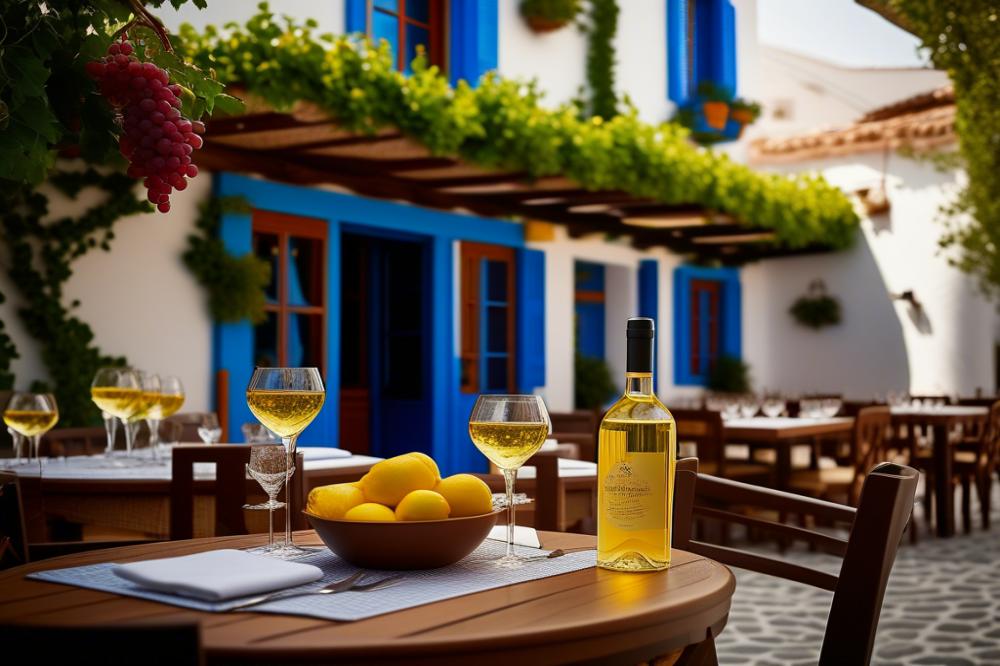The history and flavors of Retsina wine in Greek cuisine
Retsina wine holds a special place in the heart of Greek cuisine. This traditional beverage has a rich history that dates back thousands of years. It is well-known for its distinct flavors, which come from the addition of resin during the wine-production process. This unique practice began as a practical way to protect the wine from spoilage, but it evolved into a cherished culinary tradition.
The story of Retsina is intertwined with Greece’s cultural heritage. Ancient Greeks enjoyed this wine, and it often accompanied social gatherings and important celebrations. Today, it remains a symbol of the Mediterranean lifestyle. Vineryards across the country continue to produce this iconic drink, maintaining recipes that have been passed down through generations.
Food pairing plays a significant role in the enjoyment of Retsina. This wine complements a variety of traditional dishes, enhancing the overall dining experience. Whether served with grilled meats or seafood, its resinous character adds a distinctive touch. Culinary travelers often seek out Retsina as part of their gastronomic adventures in Greece.
As travelers explore the country’s diverse culinary landscape, the significance of this wine cannot be overlooked. Retsina is more than just a drink; it is a bridge to the past and a testament to the flavors of Greek cuisine. Each sip tells a story, inviting those who partake to connect with the rich traditions of the region.
History of Retsina Wine

The story of Retsina wine dates back to ancient Greece. Some believe it originated over 2,000 years ago. Early Greeks used pine resin to seal their clay amphorae. This practice helped protect the wine from spoilage. Over time, people began to enjoy the flavor the resin added to the wine.
Historical production methods reveal much about its evolution. Ancient vineyards played a crucial role in creating this drink. Grapes were grown in the sun-drenched regions of the Mediterranean. Local winemakers discovered that adding resin could impart a unique flavor. They mixed it with white grape varieties like Savatiano. This combination led to a taste that was both refreshing and complex.
Retsina has changed considerably through different periods in Greek history. Traditionally, it was a common beverage enjoyed by everyone. In the past few centuries, it faced challenges with changing tastes. However, skilled winemakers continued to refine the process. Innovations began to emerge, leading to better quality Retsina. Today, some producers focus on enhancing its flavors even further.
Cultural heritage is vital to understanding Retsina’s significance. It often accompanies traditional dishes like grilled octopus or Greek salad. Many families have rituals that include sharing this wine at gatherings. Festivals and celebrations frequently feature Retsina as part of the feast. This connection to food pairing ensures it remains a beloved part of Greek life.
Overall, this wine represents a link to the past. Its flavors tell stories of generations. Each bottle captures a piece of Greece’s rich, vibrant culture. The legacy of Retsina wine is intertwined with the very essence of Greek traditions.
Flavors and Characteristics

Retsina wine has a distinct flavor profile that sets it apart from other varieties. The infusion of pine resin plays a crucial role in its taste and aroma. This resin, historically used for sealing wine jars, adds layers of complexity. As a result, drinkers often notice hints of herbal notes and a refreshing finish.
The influence of resin gives this wine a characteristic sharpness. It can be quite herby and citrusy, with an underlying bitterness. Some might even describe it as having a slight piney essence. Those flavors make Retsina an exciting option for adventurous palettes.
When one compares Retsina to other Mediterranean wines, differences become clear. Many regional wines embrace fruit-forward profiles, emphasizing grapes’ natural sweetness. In contrast, Retsina offers a more robust and earthy experience. Those looking for something more traditional will find this wine aligns beautifully with Greece’s culinary customs.
Grape varietals commonly used in Retsina production include Assyrtiko, Savatiano, and Roditis. Each grape contributes its own characteristics to the final product. Assyrtiko, for instance, is known for its high acidity and minerality, which pairs beautifully with the resinous flavor. Meanwhile, Savatiano adds mellowness and depth to the taste.
Traditional dishes often accompany Retsina, enhancing the dining experience. Foods like grilled seafood, lamb, or meze platters benefit from this wine’s unique taste. The balance between the wine’s sharpness and the flavors of Greek cuisine results in harmonious food pairing. Cultural heritage shines through each sip, showcasing the timeless relationship between Retsina and Greek gastronomy.
Wine Production Process

Retsina wine embodies a rich history intertwined with Greek culture. Its production begins with the careful selection of grapes. Usually, the Assyrtiko or Savvatiano grapes are chosen for their ability to adapt to local climates. Once harvested, grapes go through destemming and crushing, allowing their juice to flow freely.
Adding resin is a distinctive step in this winemaking process. Traditionally, Aleppo pine resin is used, imparting the unique flavors characteristic of this wine. After pressing the grapes, the resin is added during fermentation. The resin not only influences taste but also helps preserve the wine, much like ancient methods did.
In various regions of Greece, production techniques can differ significantly. For instance, vineyards in Attica may embrace slightly different methods than those in Santorini. Local practices and family traditions greatly impact the final product. Some winemakers prefer to use less resin, resulting in a lighter flavor, while others opt for a more pronounced resin presence.
Climate and terroir also play crucial roles in defining the characteristics of Retsina. Mediterranean weather offers long, sunny days, which help develop the grapes’ sugars. The soil type influences how the plant absorbs minerals, shaping the wine’s overall profile. Different areas may yield wines with distinct flavor notes, influencing food pairing options.
Pairing Retsina with traditional dishes showcases the wine’s versatility. Olive oil, grilled meats, and fresh fish are often highlighted in many meals. These combinations enhance tasting experiences and reflect cultural heritage. The history of this unique wine continues to evolve, rooted in centuries of winemaking traditions that honor Greece’s past and present.
Traditional Dishes Paired with Retsina

Certain traditional dishes from Greece enhance the enjoyment of Retsina. These meals often come from various regions. Ingredients and preparation methods reflect the local culture and history. Each dish has its own character that can complement the wine’s distinct resin flavors.
Mezes, or small dishes, are an excellent way to start. They include options like olives, feta cheese, and grilled octopus. The saltiness of olives and the richness of feta work well with the wine’s herbaceous notes. In many taverns, sharing these plates is part of the experience, promoting a sense of community.
Iconic Plates of Greece
Souvlaki stands out as a favorite. Tender meat skewers, grilled to perfection, deliver a savory punch. The smokiness and spices enhance the resin character in the wine. It pairs wonderfully with tzatziki, a yogurt dip that cools the palate.
Another dish to consider is spanakopita. This spinach and feta pie wrapped in flaky pastry offers a delightful contrast. The buttery layers of dough complement the wine’s acidity. When enjoyed together, flavors create a harmonious experience.
Regional Specialties
Regions in Greece have their own specialties that suit Retsina well. In Crete, you might find dakos, a barley rusk topped with tomatoes and cheese. The flavors are fresh and vibrant, matching the wine’s brightness. In the Peloponnese, enjoy gyros, with its mix of spices and grilled meat, bringing out the wine’s unique profile.
Fishermen often serve freshly caught fish dressed simply with olive oil and lemon. This Mediterranean approach helps highlight Retsina’s aromatic notes. Fresh herbs in the dish, such as oregano or dill, accentuate the wine’s complex characteristics.
Cultural Practices Around Dining
Dining in Greece goes beyond just eating; it is about connection. Meals often stretch for hours, allowing for conversation and enjoyment. Retsina plays an essential role in these gatherings. The wine’s rich history and flavors encourage storytelling and sharing. Pairs of dishes create a festive spirit and communal dining experience.
Celebrations and feasts see Retsina on the table frequently. Festivals showcase wine production and regional foods, emphasizing Greece’s cultural heritage. The combination of traditional dishes and this wine helps keep customs alive. Its presence is felt in family gatherings and special occasions alike.
Thus, pairing Retsina with local dishes is more than taste; it is an exploration of Greece’s rich culinary landscape. The communion of flavors and cultural practices elevates the dining experience into something memorable. Enjoying this wine with food captures the essence of Mediterranean hospitality.
The Role of Retsina in Mediterranean Cuisine
Retsina has a distinct place within the rich tapestry of Mediterranean culinary practices. Wine production in the region varies widely, but few wines carry the same storied history as this Greek favorite. Its unique flavor profile comes from the pine resin added during fermentation. This resin lends a character that is rarely found in other wines. In fact, Retsina stands out among Mediterranean varieties, showcasing a heritage steeped in traditions dating back thousands of years.
Many Mediterranean wines share fruity or floral notes, but Retsina introduces a resinous complexity. While some Italian and Spanish wines highlight terroir with earthiness, the Greek version leans into the aromatic. This difference in flavors showcases the diversity of the region’s viticulture. Vineyards in Greece often grow indigenous grape varieties that thrive in its varied climate. Local practices and the influence of the land shape the wine’s final taste.
Retsina shines in traditional dishes, pairing well with Greek meze, grilled seafood, or even roasted lamb. The wine’s acidity complements flavors found in these meals, enhancing the overall dining experience. Contemporary dining also embraces Retsina, expanding its presence in modern cuisine. Chefs nowadays experiment with new food pairing options, finding balance with spicy dishes or rich cheeses.
This wine is not merely a component of history; it plays a vibrant role in Greece’s cultural heritage. It represents a connection to past generations who enjoyed it with family and friends. As globalization continues to influence dining habits, many are discovering Retsina’s versatility. It may add a surprising twist to meals not typically associated with Greek cuisine. Enthusiasts are now exploring ways to incorporate this wine into various culinary experiences.
In summary, Retsina offers a unique perspective within the larger Mediterranean framework. Its flavors, shaped by time and tradition, invite new appreciation on dining tables around the world. The conversation about this wine reflects a deeper understanding of Mediterranean culture, showcasing both its history and evolution.
Final Thoughts on Retsina Wine
Retsina wine holds a treasured spot in Greek cuisine, reflecting its deep-rooted history. Many locals see it as more than just a drink; it symbolizes their cultural narrative. The unique flavors fused with resin distinguish it from other wines, making it a staple in many traditional meals. Sip on this aromatic beverage, and you might feel transported to sun-soaked vineyards and lively tavernas in Greece.
For culinary travelers, experiencing Retsina in its authentic setting is essential. Imagine enjoying a glass with fresh seafood or savory lamb under the shaded awnings of a rustic restaurant. Local chefs serve this wine proudly, pairing it with dishes that elevate its qualities. You will gain insights into Greece’s storied heritage when tasting it right where it originated.
Modern gastronomy is evolving, yet Retsina continues to stand its ground. New producers are experimenting with flavors while respecting tradition. This progression highlights the wine’s versatility and adaptability. Even if you are new to wine, Retsina offers an accessible entry point into Greek culture. It invites everyone to savor the past while enjoying the present.
In essence, embracing this iconic beverage is about more than just taste. It is a journey through Greece’s culinary landscape, where every sip can tell a story. Whether you’re a novice or a seasoned enthusiast, Retsina brings people together, igniting authentic conversations and shared experiences.



